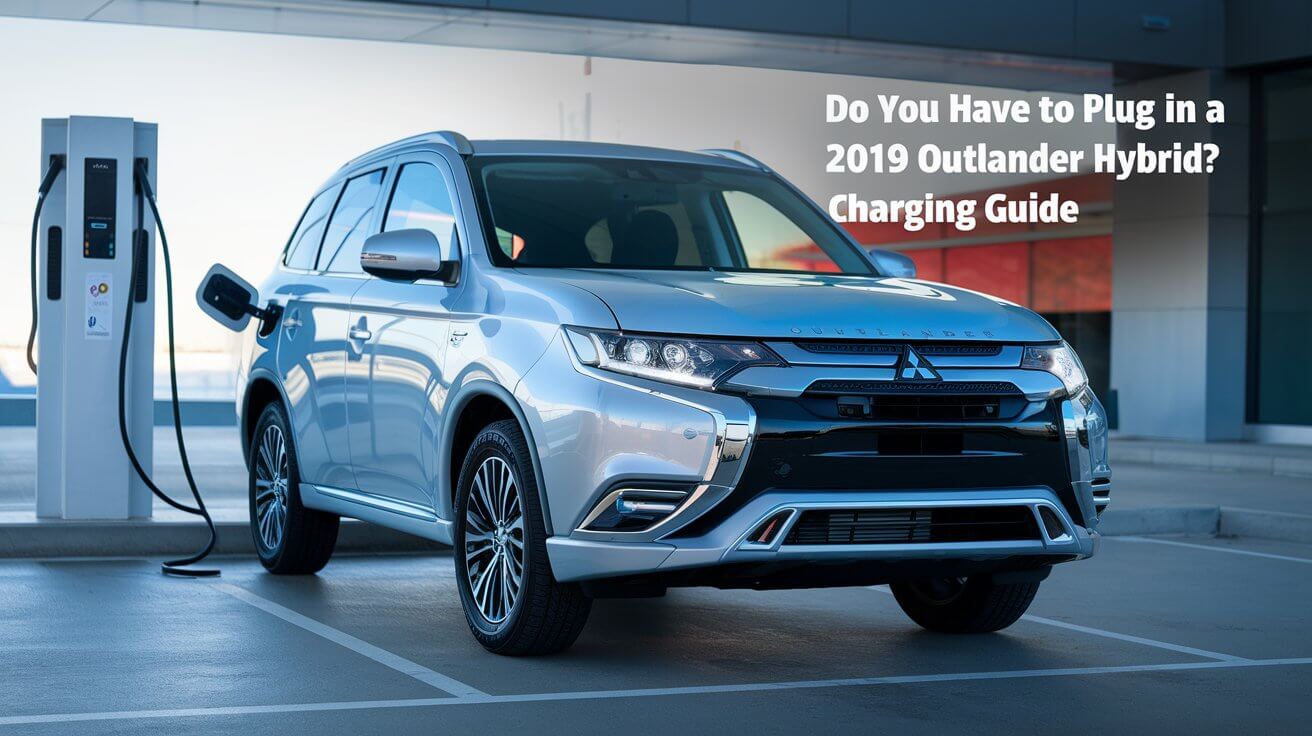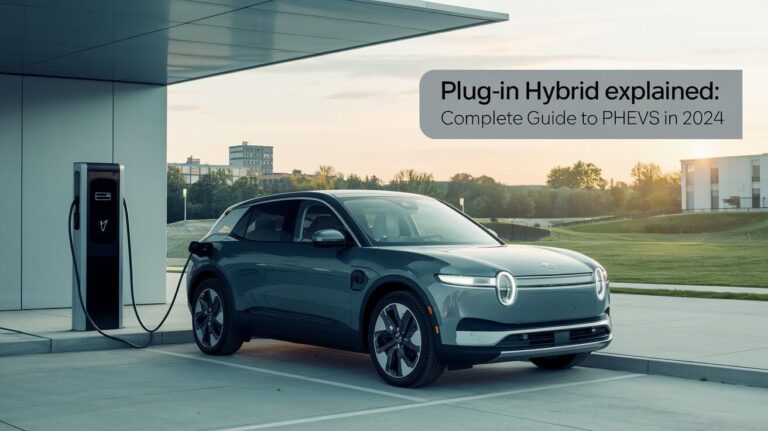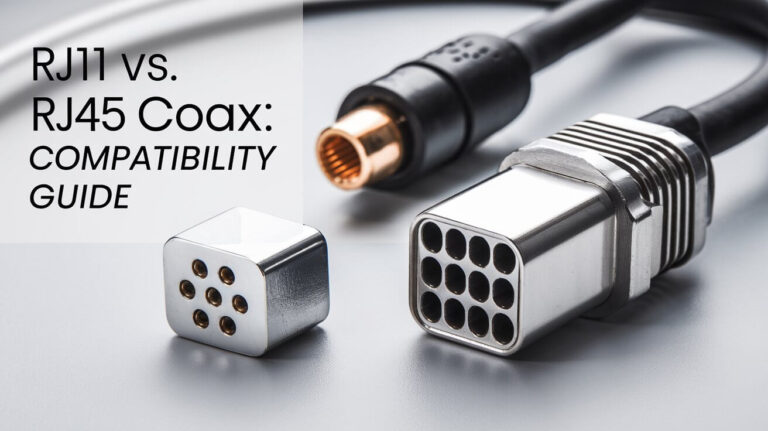Do You Have to Plug in a 2019 Outlander Hybrid? Charging Guide

The 2019 Mitsubishi Outlander PHEV (Plug-in Hybrid Electric Vehicle) offers drivers flexibility: it operates on both electric power and gasoline. For drivers wondering, do you have to plug in a 2019 Outlander Hybrid? the answer is no, but plugging in is highly recommended for the best performance and efficiency. With a charging cable included, owners can plug in to achieve optimal fuel savings, especially on shorter drives where electric-only power shines.
This guide will explore everything you need to know about the 2019 Outlander PHEV, including its charging options, fuel economy, hybrid functionality, and environmental benefits. Read on for a comprehensive look at this popular plug-in hybrid, designed for both everyday convenience and fuel efficiency.
What Is a Plug-In Hybrid Electric Vehicle (PHEV)?
A Plug-In Hybrid Electric Vehicle, or PHEV, is a hybrid model that combines a gasoline engine with a rechargeable electric battery. Unlike traditional hybrids, which recharge solely through regenerative braking, PHEVs can be plugged into an external source to recharge the battery. This setup provides greater electric-only range and reduces reliance on gasoline.
The 2019 Mitsubishi Outlander PHEV operates with:
- A 2.0-liter gasoline engine combined with two 60 kW electric motors
- A 12 kWh lithium-ion battery
- Electric-only range of about 22-28 miles on a full charge
The Outlander PHEV is ideal for short, local commutes when charged regularly, but it switches to gasoline once the electric charge depletes, offering flexibility for longer drives.
Electric Charging Basics for the 2019 Outlander
The 2019 Outlander PHEV’s charging system is straightforward. You can use standard outlets, higher-voltage chargers, or fast-charging stations. Here’s a closer look:
Battery and Charging Options
The Outlander PHEV includes a 12 kWh lithium-ion battery that powers its electric motors. You can recharge the battery with:
- Standard 120V Outlet: This basic charging method takes around 8 hours, suitable for overnight home charging.
- Level 2 (240V) Charger: Often found in public stations and some homes, Level 2 charging can fully recharge the battery in about 3.5 hours.
- DC Fast Charging: Utilizing CHAdeMO fast chargers, available at select locations, the battery can reach 80% in just 25 minutes.
Charging Times in Real-World Context
With an electric range around 22 miles per full charge, overnight charging through a standard outlet provides ample range for most commutes. If you have access to faster charging, such as at work or public stations, you’ll be able to recharge more frequently, keeping the vehicle’s fuel economy at its peak.
Convenience and Accessibility of Charging Options
Public charging networks are rapidly expanding, especially in urban areas, making it easier than ever to recharge PHEVs like the Outlander. For those with limited access to public chargers, installing a Level 2 home charger is an option to consider, offering faster charge times and ensuring a full battery each morning.
Electric-Only Range and Performance
The Outlander PHEV’s electric-only range of roughly 22-28 miles suits drivers with shorter commutes or city driving habits. The battery can cover local trips without engaging the gasoline engine, reducing emissions and fuel costs.
Electric-Only Range: Urban and Suburban Driving
Many owners find the electric-only mode ideal for daily activities—school drop-offs, shopping trips, or short commutes. Since the gas engine remains off, you’ll experience a quieter drive with no emissions. In suburban or urban areas with plenty of public charging, drivers can extend electric-only driving significantly.
Highway vs. City Performance
City driving allows for maximum efficiency on electric power, as regenerative braking can recapture energy during stop-and-go traffic. On the highway, however, electric-only range may decrease slightly due to higher sustained speeds, and the gasoline engine will often activate when the battery depletes.
Regenerative Braking: Extending Electric Range
One unique feature of the 2019 Outlander PHEV is its regenerative braking system. When the brakes are applied, or the vehicle coasts, the electric motors help slow the car and convert energy back to the battery.
Regenerative Braking Modes
Drivers can choose from different regenerative braking levels to control energy recovery. These settings range from a light effect (B0 mode) to more aggressive regeneration (B5 mode), where you’ll rarely need to press the brake pedal. This system extends electric range by recapturing energy that would otherwise be lost, especially useful for city driving.
Fuel and Hybrid Power Mode: When the Battery Depletes
Once the battery depletes, the Outlander PHEV automatically switches to hybrid mode. In this mode, the vehicle operates using a combination of gasoline and electric power to maintain efficiency and performance.
Hybrid Mode Overview
Hybrid mode engages the 2.0-liter gasoline engine alongside the electric motors. The vehicle dynamically balances between gasoline and electric use to maximize fuel economy, which Mitsubishi rates around 25 miles per gallon (MPG) in hybrid mode.
Engine Performance and Output
With a combined output of 190 horsepower from the gasoline engine and twin electric motors, the Outlander PHEV offers smooth acceleration and solid performance, especially in everyday driving scenarios. While it may not have the rapid acceleration of some all-electric SUVs, it’s well-suited for daily commutes and family trips.
Charging vs. Gasoline: Cost Comparison
Using electric power can result in substantial fuel savings over time. Here’s a breakdown of costs for each mode:
Electricity Costs
The cost to fully charge the battery at home is approximately $0.80 (based on average U.S. electricity rates). With an estimated electric-only range of 22 miles, this translates to a highly affordable driving cost, especially compared to gas-only vehicles.
Gasoline Costs
While gasoline is needed for longer trips, charging regularly and relying on electric power for daily use keeps gas costs low. Drivers who frequently use the battery’s electric range can expect significantly reduced gasoline use compared to non-hybrid SUVs.
Overall Savings Potential
For typical drivers, regular charging can yield notable savings in fuel costs, especially if they primarily use electric mode. While hybrid mode offers solid fuel economy, maximizing electric power remains the most cost-effective option.
Can You Drive the Outlander Without Plugging It In?
Yes, the Outlander PHEV can run without plugging in; however, doing so reduces the benefits of owning a PHEV. Running the vehicle without charging means it will rely mostly on gasoline, performing as a traditional hybrid.
Performance and Fuel Economy Without Charging
If left uncharged, the Outlander will function as a standard hybrid, blending gasoline and limited electric power. While you won’t achieve the full electric range, regenerative braking still recharges the battery slightly, improving fuel efficiency over a conventional gas-only vehicle.
Ideal Use Cases for Plugging In
To fully benefit from the PHEV setup, plugging in is recommended. Regular charging is particularly useful for urban or suburban drivers with shorter commutes, allowing them to maximize fuel savings and reduce environmental impact.
Environmental Benefits of Plugging In
Plugging in the Outlander PHEV not only saves on fuel costs but also reduces carbon emissions, contributing to cleaner air and environmental benefits.
Emissions Reduction in EV Mode
In electric-only mode, the Outlander produces zero tailpipe emissions. Regular charging can keep emissions to a minimum, especially for drivers who can cover most of their daily mileage on electric power.
Reduced Fuel Dependency
By relying more on electricity, drivers reduce their gasoline consumption, supporting both environmental goals and reducing dependence on fossil fuels.
Practicality and Convenience: Living with the Outlander PHEV
The 2019 Outlander PHEV offers practical features, making it suitable for everyday use. Here’s what owners can expect:
Home and Public Charging Options
Home charging is convenient for most owners, especially with the option for an overnight charge. However, public charging stations offer flexibility for those who can’t charge at home. With an increasing network of stations, it’s easier to find charging points, especially in urban areas.
Managing Longer Trips
On longer journeys, the Outlander’s hybrid mode ensures drivers can travel without worrying about charging stops. While public chargers can supplement range on road trips, the gasoline engine provides peace of mind for extended travel.
Key Features of the 2019 Outlander PHEV
Beyond its hybrid powertrain, the Outlander PHEV offers a variety of comfort, tech, and safety features:
Technology and Infotainment
Equipped with a 7-inch touchscreen with Apple CarPlay and Android Auto, the Outlander ensures drivers stay connected. Bluetooth and dual USB ports further enhance in-car convenience.
Safety and Driver Assistance Features
Safety features include rearview camera, blind-spot monitoring, lane-change assist, and rear cross-traffic alert, making the Outlander a secure choice for families.
Interior Space and Comfort
With a spacious cabin and generous cargo capacity, the Outlander PHEV meets the needs of families and active drivers alike. The flexible seating and comfortable layout provide a smooth experience on both short and long drives.
Pros and Cons of Plugging in the Outlander PHEV
Benefits of Charging
- Fuel Cost Savings: Regular charging reduces gasoline costs.
- Lower Emissions: Plugging in minimizes emissions, especially on short trips.
- Better Performance: Electric mode offers a quiet and efficient driving experience.
Drawbacks
- Charging Time: While Level 2 chargers speed up the process,Continuing from above:
- Charging Infrastructure: Not all areas have abundant charging stations, which can limit convenience on long trips or in rural areas.
- Initial Charger Cost: If drivers choose to install a Level 2 home charger, there may be an upfront cost.
Addressing Common Concerns about Plug-In Hybrids
Battery Longevity and Warranty
The 2019 Outlander PHEV comes with a battery warranty, typically around 8 years or 100,000 miles, providing peace of mind. Mitsubishi’s engineering ensures that the lithium-ion battery retains capacity over time, even with regular charging.
Cold Weather Performance
Cold weather can impact battery performance, potentially reducing electric-only range. The Outlander PHEV remains fully functional in cold conditions, but owners may experience a shorter range due to the battery’s chemistry. Pre-conditioning the cabin while plugged in can help mitigate these effects.
Comparing the Outlander PHEV with Competitors
While the Outlander PHEV leads in affordability and practicality, other plug-in hybrids offer alternatives for drivers looking for specific features.
Mitsubishi Outlander vs. Toyota RAV4 Prime
The Toyota RAV4 Prime, another popular PHEV, offers longer electric range and higher horsepower. However, the Outlander remains a budget-friendly option, especially with its extensive safety and tech features.
Value Proposition for the Outlander
Among plug-in hybrids, the 2019 Outlander PHEV stands out for its balance of electric and gas performance, spacious interior, and cost-effective price point, appealing to drivers who want a functional and economical SUV.
Conclusion: Is Plugging in the Outlander Necessary?
In summary, while plugging in the 2019 Outlander PHEV isn’t required, it’s highly recommended. Charging enables drivers to maximize fuel savings, enjoy quieter electric performance, and reduce emissions. With flexible charging options, both at home and on the go, the Outlander provides an ideal solution for those looking for a greener, more economical driving experience without sacrificing convenience or performance. For drivers ready to embrace a hybrid lifestyle, the 2019 Outlander PHEV delivers reliability, comfort, and savings in a versatile SUV.




